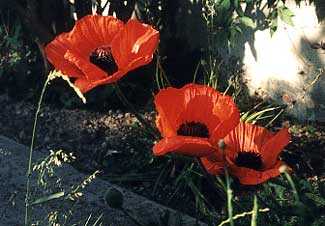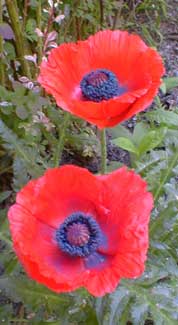 | |
|
The ruddy poppies bend & bow, Diane! do you remember? The sun you knew shines proudly now, The lake still lists the breeze's vow, Your towers are fairer for their stains, Each stone you smiled upon remains. Sing low--where is Diane? Diane! do you remember? I come to find you through the years, Diane! do you remember? For none may rule my love's soft fears. The ladies now are not your peers, I seek you through your tarnished halls, Pale sorrow on my spirit falls, High, low--where is Diane? Diane! do you remember? I crush the poppies where I tread, Diane! do you remember? Your flower of life, so bright, so red-- She does not hear--Diane is dead. I pace the sunny bowers alone Where naught of her remains but stone. Sing low„where is Diane? Diane does not remember. -Helen Hay Whitney, | |
The Symbolism of the Red Poppies
Mmmmm, smells like opium, it surely do. Even though the narcotic content is minimal to absent in the red Perennial Poppy (Papaver orientalis) or the annual Red Poppy (P. rhoeas), the odor of the vibrant new flowers will nevertheless give you some sense of the odor of opium poppies (P. somniferum), evocative of dens & decadence. Although the most commonly gardened poppies are in no manner opiating, others do have medicinal properties valued by herbalists, & red poppies have been for millenia regarded as a curative for sleeplessness.
Red Poppy is known variously as Field Poppy, Wild Poppy, Rose Poppy, Headache Flower, Shirley Poppy (after a location in England), Canker Flower, Copper Rose, Red Weed, or Redfield. It is called Corn Poppy, Corn Rose, Corn Flower, or Demeter's Flower, because the Greeks & Romans encouraged it to self-seed in ploughed ground amidst grains, with the belief that the Great Mother would not make millet grow without the presence of poppies. It's called American Legion Poppy, Memoral Day Poppy, or Flanders Poppy after its wartime associations.
 Red Poppy is a native of Eurasia but is now naturalized in many areas of North America. It has many color varieties but the wild form is pure bright red.
Red Poppy is a native of Eurasia but is now naturalized in many areas of North America. It has many color varieties but the wild form is pure bright red.The similar-looking strongly perennial P. orientalis is also known as Red Poppy though it too comes in other colors. It is also known as Perennial Poppy & Oriental Poppy. It has large, impressive blooms.
The cultivar sold as 'Brilliant' is close to the wild form in appearance, & is the very cultivar shown on this page. The clump shown in the above photo has always been in the yard, & comes back every year without help or hindrance. Although ordinarily they are major sun-lovers, this clump flourishes in considerable shade. Another clump of 'Brilliant' is in a roadside sun-garden with several other varieties of perennial poppy, including 'Royal Wedding' which is white with purple splotches in the center, salmon-pink 'Princess Victoria Louise,' & others.
The twin underworld gods Thanatos & Hypnos were frequently depicted with poppies, which acknowledges the two best known traits of poppies, Hypnos of the red oriental poppy indicating peaceful slumber, & the Thanatos deathly & addictive opium poppy.
In ancient Greece & Rome, the Red Poppy symbolized the Goddess Demeter (Ceres). She either found the poppy in a distant place while wandering the world looking for her daughter; or, when the gods one by one attempted to ease her anguish over the loss of Persephone, Hypnos (Somnus) created the Red Poppy hoping it would assist the Great Mother in obtaining rest.
Persephone's pomegranate, which fed her but three seeds during her stay in Tartarus, was originally a seedpod of the same Red Poppy. It became a pomegranate in a later age, when artworks showing Persephone with a giant seedpod was mistaken for a similarly-shaped pomegranate.
When John McCrae wrote his famous poem of the dead in the First World War, which ends, "We shall not sleep though poppies grow in Flanders Field," the red poppy was already symbolic of eternal sleep. Its petals were supposed to look like spilled blood, & even when the wardead were taken away in body-bags, the stained earth was still reminiscent of a field of poppies. And it had been noted even in the Napoleonic Wars that where so many graves were required, Red Poppies erupted naturally from the fresh-turned earth.
By the end of the War to End All Wars, the British & Canadian Legions were using the Red Poppy as a symbol of soldiers dead or maimed in the war. It was quickly adopted in the United States too, a symbol of Veterans of Foreign Wars. It remains today the symbol of the American Legion. It is a somewhat fading tradition, but seeds of red poppies were long planted by children on the graves of the war dead on Memorial Day, so that no generation would forget the Great War & the soldiers who who died.
To the other end of the political scale, in Russia & China, the red poppy became a symbol of Revolution, commemorated in Igor Schwezoff's & Reinhold Gliere's operatic ballet The Red Poppy (1927; oversensitive Soviets demanded it be revised as "The Red Flower" to avoid any intimation of opium use).
Meanwhile in the United States, at the same time as the Red Poppy was being used as a symbol of soldiers dead or injured in the war, it was simultaneously symbolic of radical unionizing activity.
The Red Poppy became a labor-activist comic strip character beginning in the January 17, 1931 issue The Daily Worker & ran until its creator, Arthur Carr, was vengefully deported to Italy by a government dead-set against workers' interest generally, & American communmists specifically. The character was adapted in two Monograph Pictures starring Wallace Berry, Vanlandingham's Secret (1932) & In Labor's House (1933), while radio's The Mercury Theater produced a series Tales of the Red Poppy starring Joseph Cotten in the titular role, with scripting by Orson Welles.